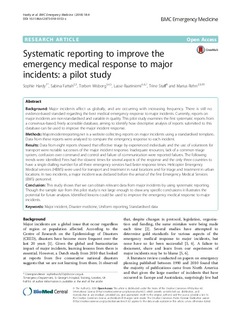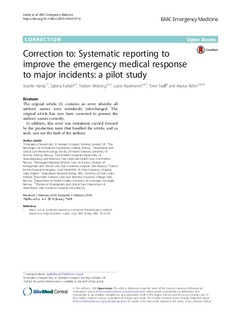| dc.contributor.author | Hardy, Sophie | |
| dc.contributor.author | Fattah, Sabina | |
| dc.contributor.author | Wisborg, Torben | |
| dc.contributor.author | Raatiniemi, Lasse | |
| dc.contributor.author | Staff, Trine | |
| dc.contributor.author | Rehn, Marius | |
| dc.date.accessioned | 2019-01-22T08:48:04Z | |
| dc.date.available | 2019-01-22T08:48:04Z | |
| dc.date.created | 2018-06-21T14:38:26Z | |
| dc.date.issued | 2018-01 | |
| dc.identifier.citation | Hardy, S. et al. (2018) Systematic reporting to improve the emergency medical response to major incidents: A pilot study. BMC Emergency Medicine. 18(4), pp. 1-7. | nb_NO |
| dc.identifier.issn | 1471-227X | |
| dc.identifier.uri | http://hdl.handle.net/11250/2581686 | |
| dc.description.abstract | Background: Major incidents affect us globally, and are occurring with increasing frequency. There is still no evidence-based standard regarding the best medical emergency response to major incidents. Currently, reports on major incidents are non-standardised and variable in quality. This pilot study examines the first systematic reports from a consensus-based, freely accessible database, aiming to identify how descriptive analysis of reports submitted to this database can be used to improve the major incident response.
Methods: Majorincidentreporting.net is a website collecting reports on major incidents using a standardised template. Data from these reports were analysed to compare the emergency response to each incident.
Results: Data from eight reports showed that effective triage by experienced individuals and the use of volunteers for transport were notable successes of the major incident response. Inadequate resources, lack of a common triage system, confusion over command and control and failure of communication were reported failures. The following trends were identified: Fires had the slowest times for several aspects of the response and the only three countries to have a single dialling number for all three emergency services had faster response times. Helicopter Emergency Medical services (HEMS) were used for transport and treatment in rural locations and for triage and treatment in urban locations. In two incidents, a major incident was declared before the arrival of the first Emergency Medical Services (EMS) personnel.
Conclusion: This study shows that we can obtain relevant data from major incidents by using systematic reporting. Though the sample size from this pilot study is not large enough to draw any specific conclusions it illustrates the potential for future analyses. Identified lessons could be used to improve the emergency medical response to major incidents. | nb_NO |
| dc.language.iso | eng | nb_NO |
| dc.publisher | BioMed Central | nb_NO |
| dc.rights | Navngivelse 4.0 Internasjonal | * |
| dc.rights.uri | http://creativecommons.org/licenses/by/4.0/deed.no | * |
| dc.subject | emergency medical services | nb_NO |
| dc.subject | akuttmedisin | nb_NO |
| dc.subject | major incident | nb_NO |
| dc.subject | uniform reporting | nb_NO |
| dc.title | Systematic reporting to improve the emergency medical response to major incidents: A pilot study | nb_NO |
| dc.type | Journal article | nb_NO |
| dc.type | Peer reviewed | nb_NO |
| dc.description.version | publishedVersion | nb_NO |
| dc.rights.holder | © The Author(s) 2018 | nb_NO |
| dc.subject.nsi | VDP::Medisinske Fag: 700::Klinisk medisinske fag: 750 | nb_NO |
| dc.source.pagenumber | 1-7 | nb_NO |
| dc.source.volume | 18:4 | nb_NO |
| dc.source.journal | BMC Emergency Medicine | nb_NO |
| dc.identifier.doi | 10.1186/s12873-018-0153-x | |
| dc.identifier.doi | 10.1186/s12873-018-0157-6 | |
| dc.identifier.cristin | 1592985 | |
| cristin.unitcode | 217,13,1,0 | |
| cristin.unitname | Avdeling for folkehelse | |
| cristin.ispublished | true | |
| cristin.fulltext | original | |
| cristin.qualitycode | 1 | |


